BUS200: Research Methods - Observation Techniques Report
VerifiedAdded on 2023/01/05
|18
|6193
|2
Report
AI Summary
This report delves into the application of observation methods within the context of business research. It begins by defining observation and outlining its purpose in gathering qualitative data, emphasizing the collection of information on actions rather than stated intentions. The report then presents a detailed comparison of the advantages and disadvantages of observation as a data collection technique, including its simplicity versus potential for observer bias and lack of reliability. It further explores the four dimensions of observation: complete observer, observer as participant, participant as observer, and complete participant, highlighting their differing levels of researcher involvement and respondent awareness. The report also addresses observer bias, a significant disadvantage, and suggests two methods for minimizing its impact, such as training observers and establishing clear procedures. Furthermore, it critically evaluates the ethics of concealed observation, examining potential ethical concerns. Finally, the report considers the use of online surveys, questionnaire design principles, and the importance of multiple data collection methods for ensuring reliability and validity, concluding with a discussion of biases inherent in various data collection methods.
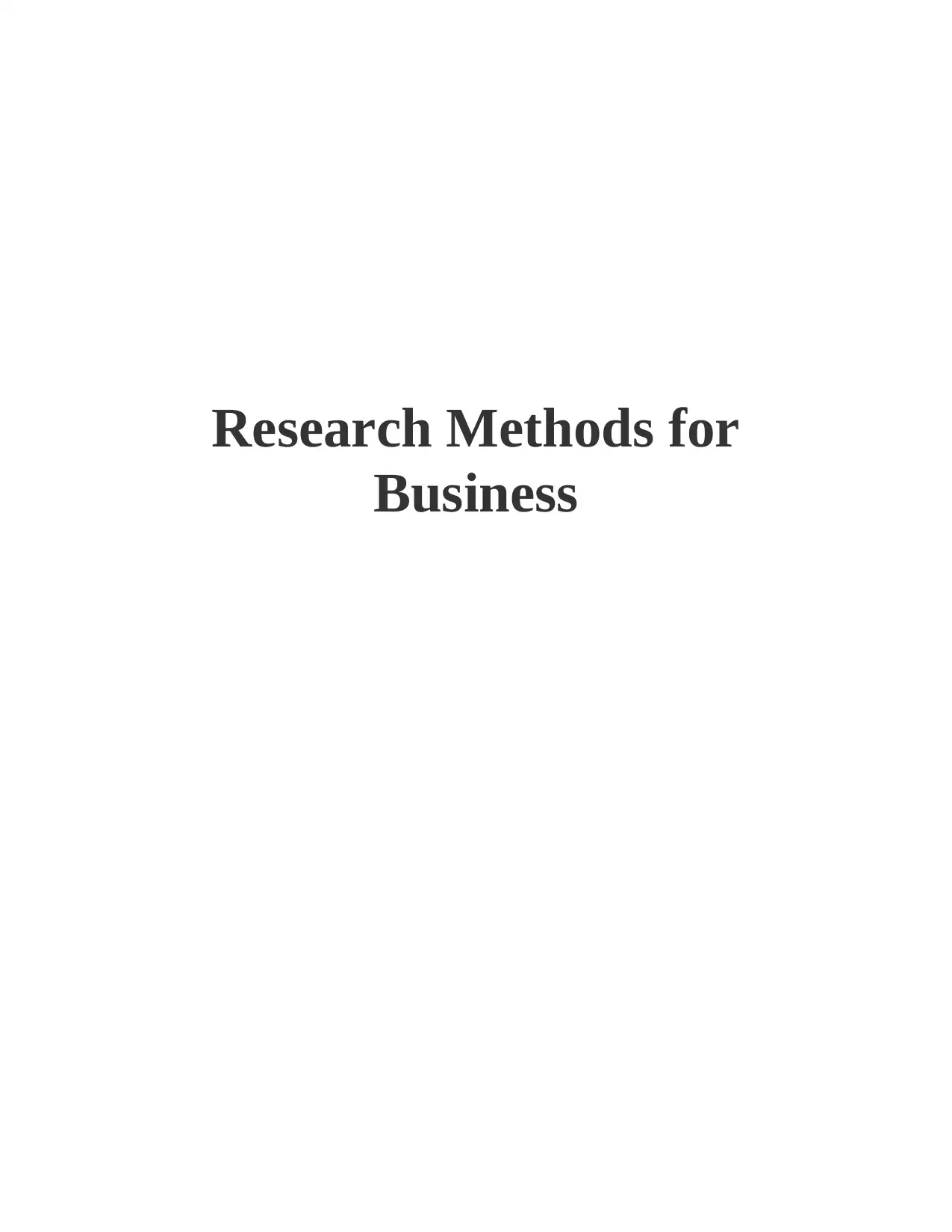
Research Methods for
Business
Business
Paraphrase This Document
Need a fresh take? Get an instant paraphrase of this document with our AI Paraphraser
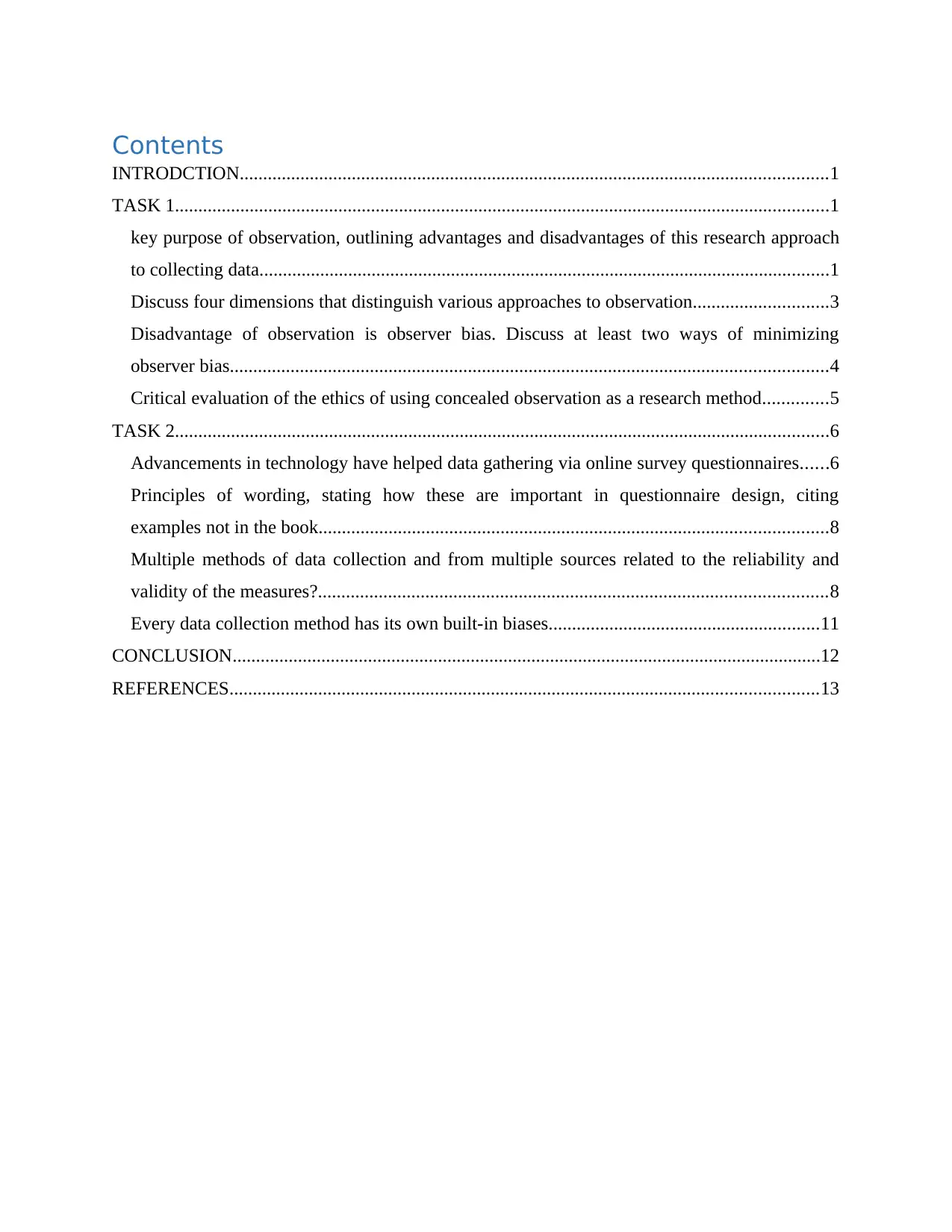
Contents
INTRODCTION..............................................................................................................................1
TASK 1............................................................................................................................................1
key purpose of observation, outlining advantages and disadvantages of this research approach
to collecting data..........................................................................................................................1
Discuss four dimensions that distinguish various approaches to observation.............................3
Disadvantage of observation is observer bias. Discuss at least two ways of minimizing
observer bias................................................................................................................................4
Critical evaluation of the ethics of using concealed observation as a research method..............5
TASK 2............................................................................................................................................6
Advancements in technology have helped data gathering via online survey questionnaires......6
Principles of wording, stating how these are important in questionnaire design, citing
examples not in the book.............................................................................................................8
Multiple methods of data collection and from multiple sources related to the reliability and
validity of the measures?.............................................................................................................8
Every data collection method has its own built-in biases..........................................................11
CONCLUSION..............................................................................................................................12
REFERENCES..............................................................................................................................13
INTRODCTION..............................................................................................................................1
TASK 1............................................................................................................................................1
key purpose of observation, outlining advantages and disadvantages of this research approach
to collecting data..........................................................................................................................1
Discuss four dimensions that distinguish various approaches to observation.............................3
Disadvantage of observation is observer bias. Discuss at least two ways of minimizing
observer bias................................................................................................................................4
Critical evaluation of the ethics of using concealed observation as a research method..............5
TASK 2............................................................................................................................................6
Advancements in technology have helped data gathering via online survey questionnaires......6
Principles of wording, stating how these are important in questionnaire design, citing
examples not in the book.............................................................................................................8
Multiple methods of data collection and from multiple sources related to the reliability and
validity of the measures?.............................................................................................................8
Every data collection method has its own built-in biases..........................................................11
CONCLUSION..............................................................................................................................12
REFERENCES..............................................................................................................................13

⊘ This is a preview!⊘
Do you want full access?
Subscribe today to unlock all pages.

Trusted by 1+ million students worldwide
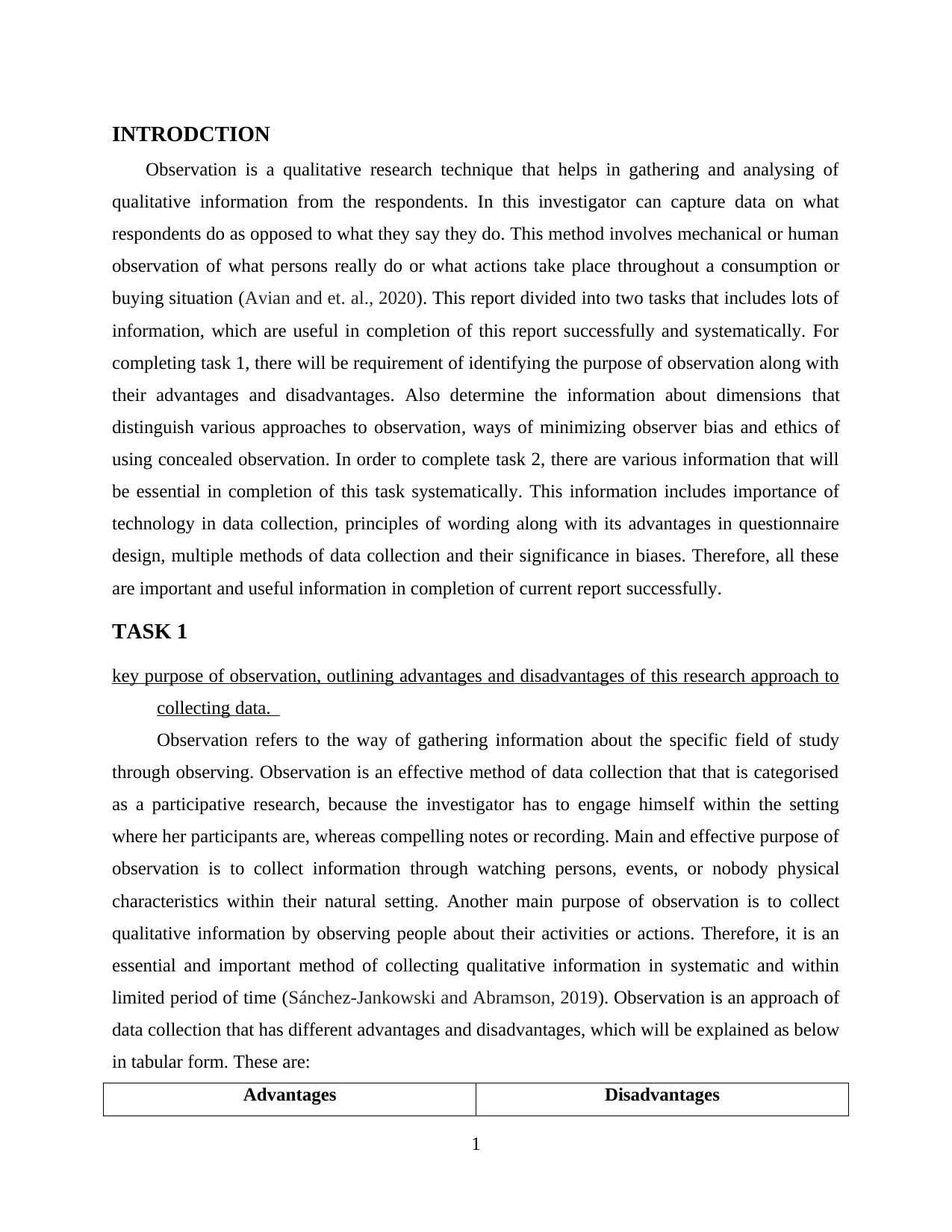
INTRODCTION
Observation is a qualitative research technique that helps in gathering and analysing of
qualitative information from the respondents. In this investigator can capture data on what
respondents do as opposed to what they say they do. This method involves mechanical or human
observation of what persons really do or what actions take place throughout a consumption or
buying situation (Avian and et. al., 2020). This report divided into two tasks that includes lots of
information, which are useful in completion of this report successfully and systematically. For
completing task 1, there will be requirement of identifying the purpose of observation along with
their advantages and disadvantages. Also determine the information about dimensions that
distinguish various approaches to observation, ways of minimizing observer bias and ethics of
using concealed observation. In order to complete task 2, there are various information that will
be essential in completion of this task systematically. This information includes importance of
technology in data collection, principles of wording along with its advantages in questionnaire
design, multiple methods of data collection and their significance in biases. Therefore, all these
are important and useful information in completion of current report successfully.
TASK 1
key purpose of observation, outlining advantages and disadvantages of this research approach to
collecting data.
Observation refers to the way of gathering information about the specific field of study
through observing. Observation is an effective method of data collection that that is categorised
as a participative research, because the investigator has to engage himself within the setting
where her participants are, whereas compelling notes or recording. Main and effective purpose of
observation is to collect information through watching persons, events, or nobody physical
characteristics within their natural setting. Another main purpose of observation is to collect
qualitative information by observing people about their activities or actions. Therefore, it is an
essential and important method of collecting qualitative information in systematic and within
limited period of time (Sánchez-Jankowski and Abramson, 2019). Observation is an approach of
data collection that has different advantages and disadvantages, which will be explained as below
in tabular form. These are:
Advantages Disadvantages
1
Observation is a qualitative research technique that helps in gathering and analysing of
qualitative information from the respondents. In this investigator can capture data on what
respondents do as opposed to what they say they do. This method involves mechanical or human
observation of what persons really do or what actions take place throughout a consumption or
buying situation (Avian and et. al., 2020). This report divided into two tasks that includes lots of
information, which are useful in completion of this report successfully and systematically. For
completing task 1, there will be requirement of identifying the purpose of observation along with
their advantages and disadvantages. Also determine the information about dimensions that
distinguish various approaches to observation, ways of minimizing observer bias and ethics of
using concealed observation. In order to complete task 2, there are various information that will
be essential in completion of this task systematically. This information includes importance of
technology in data collection, principles of wording along with its advantages in questionnaire
design, multiple methods of data collection and their significance in biases. Therefore, all these
are important and useful information in completion of current report successfully.
TASK 1
key purpose of observation, outlining advantages and disadvantages of this research approach to
collecting data.
Observation refers to the way of gathering information about the specific field of study
through observing. Observation is an effective method of data collection that that is categorised
as a participative research, because the investigator has to engage himself within the setting
where her participants are, whereas compelling notes or recording. Main and effective purpose of
observation is to collect information through watching persons, events, or nobody physical
characteristics within their natural setting. Another main purpose of observation is to collect
qualitative information by observing people about their activities or actions. Therefore, it is an
essential and important method of collecting qualitative information in systematic and within
limited period of time (Sánchez-Jankowski and Abramson, 2019). Observation is an approach of
data collection that has different advantages and disadvantages, which will be explained as below
in tabular form. These are:
Advantages Disadvantages
1
Paraphrase This Document
Need a fresh take? Get an instant paraphrase of this document with our AI Paraphraser
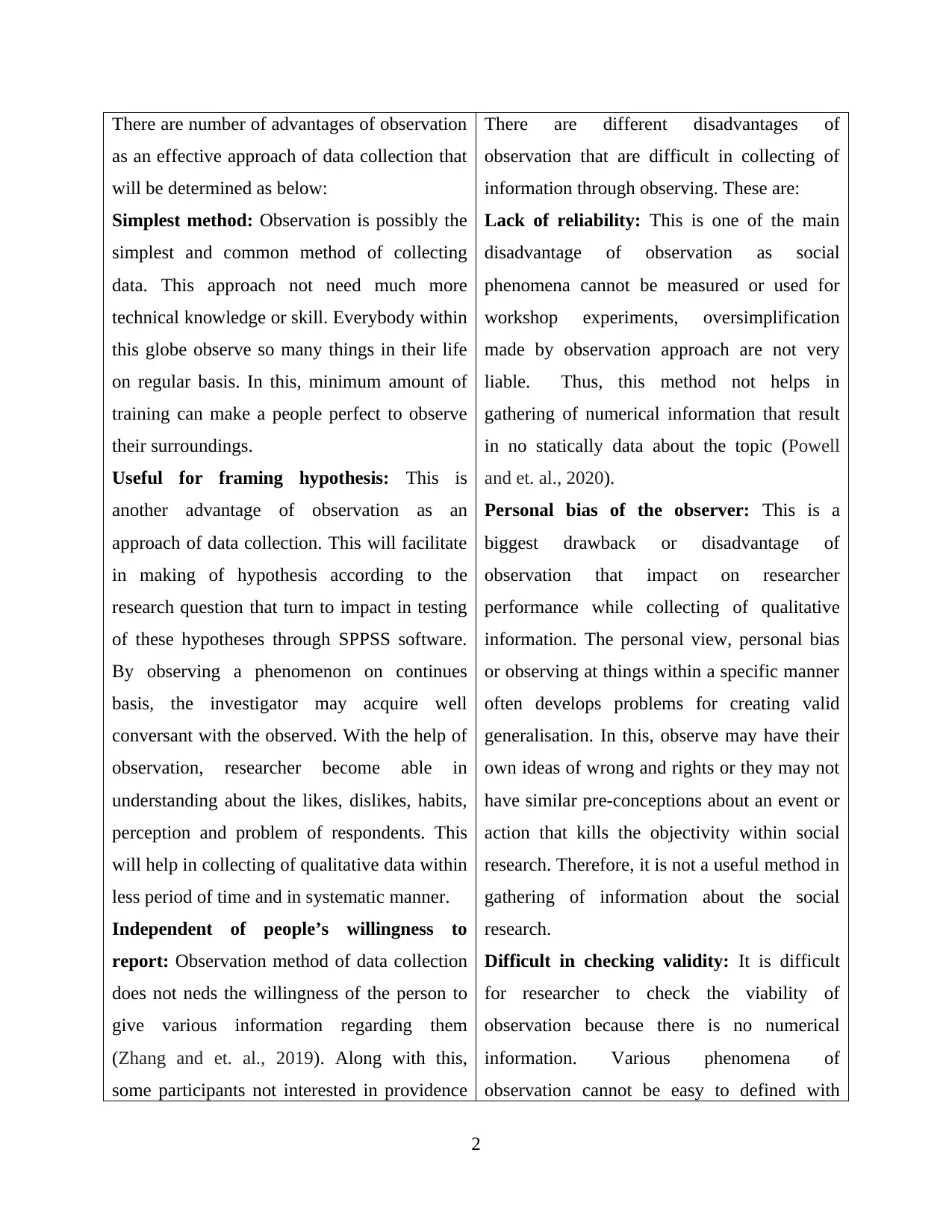
There are number of advantages of observation
as an effective approach of data collection that
will be determined as below:
Simplest method: Observation is possibly the
simplest and common method of collecting
data. This approach not need much more
technical knowledge or skill. Everybody within
this globe observe so many things in their life
on regular basis. In this, minimum amount of
training can make a people perfect to observe
their surroundings.
Useful for framing hypothesis: This is
another advantage of observation as an
approach of data collection. This will facilitate
in making of hypothesis according to the
research question that turn to impact in testing
of these hypotheses through SPPSS software.
By observing a phenomenon on continues
basis, the investigator may acquire well
conversant with the observed. With the help of
observation, researcher become able in
understanding about the likes, dislikes, habits,
perception and problem of respondents. This
will help in collecting of qualitative data within
less period of time and in systematic manner.
Independent of people’s willingness to
report: Observation method of data collection
does not neds the willingness of the person to
give various information regarding them
(Zhang and et. al., 2019). Along with this,
some participants not interested in providence
There are different disadvantages of
observation that are difficult in collecting of
information through observing. These are:
Lack of reliability: This is one of the main
disadvantage of observation as social
phenomena cannot be measured or used for
workshop experiments, oversimplification
made by observation approach are not very
liable. Thus, this method not helps in
gathering of numerical information that result
in no statically data about the topic (Powell
and et. al., 2020).
Personal bias of the observer: This is a
biggest drawback or disadvantage of
observation that impact on researcher
performance while collecting of qualitative
information. The personal view, personal bias
or observing at things within a specific manner
often develops problems for creating valid
generalisation. In this, observe may have their
own ideas of wrong and rights or they may not
have similar pre-conceptions about an event or
action that kills the objectivity within social
research. Therefore, it is not a useful method in
gathering of information about the social
research.
Difficult in checking validity: It is difficult
for researcher to check the viability of
observation because there is no numerical
information. Various phenomena of
observation cannot be easy to defined with
2
as an effective approach of data collection that
will be determined as below:
Simplest method: Observation is possibly the
simplest and common method of collecting
data. This approach not need much more
technical knowledge or skill. Everybody within
this globe observe so many things in their life
on regular basis. In this, minimum amount of
training can make a people perfect to observe
their surroundings.
Useful for framing hypothesis: This is
another advantage of observation as an
approach of data collection. This will facilitate
in making of hypothesis according to the
research question that turn to impact in testing
of these hypotheses through SPPSS software.
By observing a phenomenon on continues
basis, the investigator may acquire well
conversant with the observed. With the help of
observation, researcher become able in
understanding about the likes, dislikes, habits,
perception and problem of respondents. This
will help in collecting of qualitative data within
less period of time and in systematic manner.
Independent of people’s willingness to
report: Observation method of data collection
does not neds the willingness of the person to
give various information regarding them
(Zhang and et. al., 2019). Along with this,
some participants not interested in providence
There are different disadvantages of
observation that are difficult in collecting of
information through observing. These are:
Lack of reliability: This is one of the main
disadvantage of observation as social
phenomena cannot be measured or used for
workshop experiments, oversimplification
made by observation approach are not very
liable. Thus, this method not helps in
gathering of numerical information that result
in no statically data about the topic (Powell
and et. al., 2020).
Personal bias of the observer: This is a
biggest drawback or disadvantage of
observation that impact on researcher
performance while collecting of qualitative
information. The personal view, personal bias
or observing at things within a specific manner
often develops problems for creating valid
generalisation. In this, observe may have their
own ideas of wrong and rights or they may not
have similar pre-conceptions about an event or
action that kills the objectivity within social
research. Therefore, it is not a useful method in
gathering of information about the social
research.
Difficult in checking validity: It is difficult
for researcher to check the viability of
observation because there is no numerical
information. Various phenomena of
observation cannot be easy to defined with
2
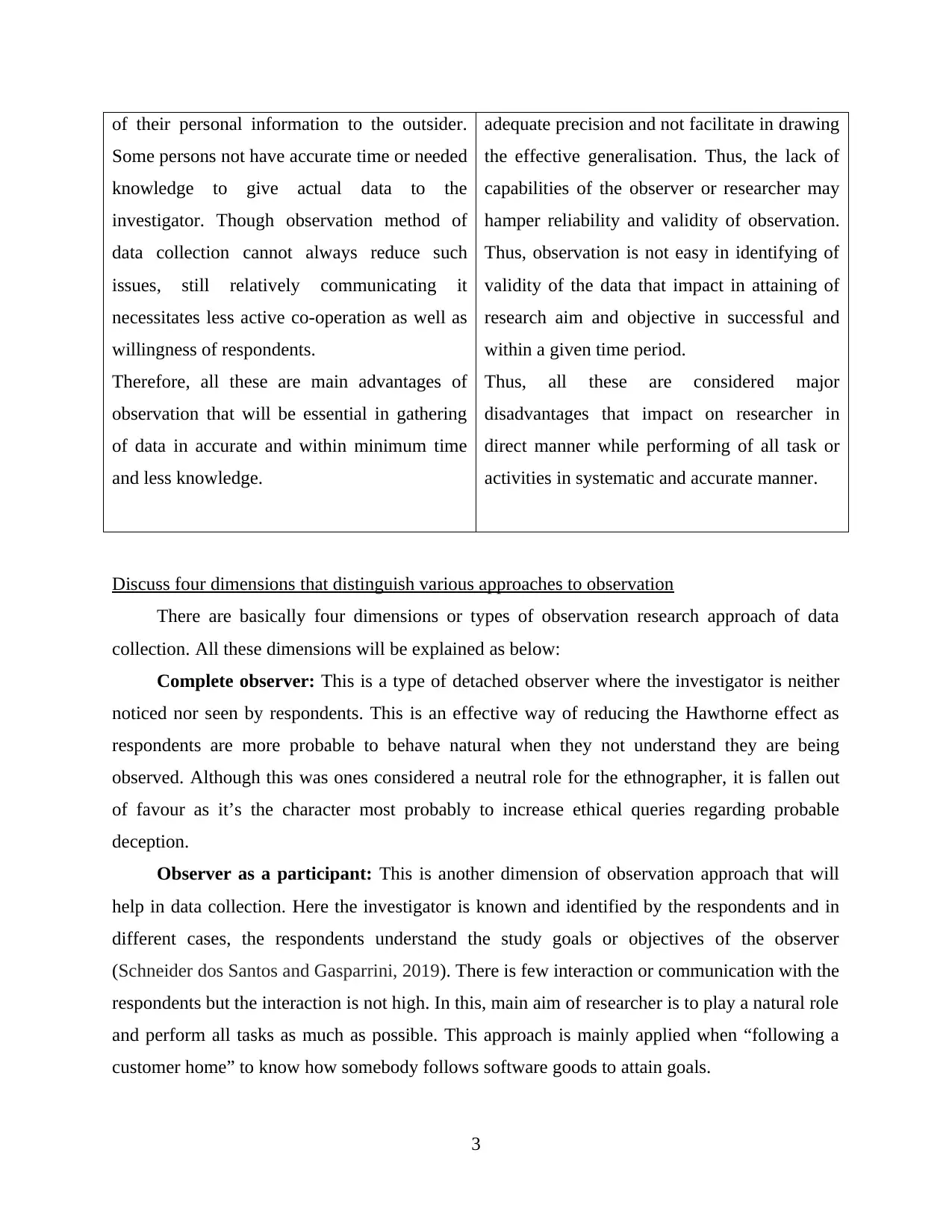
of their personal information to the outsider.
Some persons not have accurate time or needed
knowledge to give actual data to the
investigator. Though observation method of
data collection cannot always reduce such
issues, still relatively communicating it
necessitates less active co-operation as well as
willingness of respondents.
Therefore, all these are main advantages of
observation that will be essential in gathering
of data in accurate and within minimum time
and less knowledge.
adequate precision and not facilitate in drawing
the effective generalisation. Thus, the lack of
capabilities of the observer or researcher may
hamper reliability and validity of observation.
Thus, observation is not easy in identifying of
validity of the data that impact in attaining of
research aim and objective in successful and
within a given time period.
Thus, all these are considered major
disadvantages that impact on researcher in
direct manner while performing of all task or
activities in systematic and accurate manner.
Discuss four dimensions that distinguish various approaches to observation
There are basically four dimensions or types of observation research approach of data
collection. All these dimensions will be explained as below:
Complete observer: This is a type of detached observer where the investigator is neither
noticed nor seen by respondents. This is an effective way of reducing the Hawthorne effect as
respondents are more probable to behave natural when they not understand they are being
observed. Although this was ones considered a neutral role for the ethnographer, it is fallen out
of favour as it’s the character most probably to increase ethical queries regarding probable
deception.
Observer as a participant: This is another dimension of observation approach that will
help in data collection. Here the investigator is known and identified by the respondents and in
different cases, the respondents understand the study goals or objectives of the observer
(Schneider dos Santos and Gasparrini, 2019). There is few interaction or communication with the
respondents but the interaction is not high. In this, main aim of researcher is to play a natural role
and perform all tasks as much as possible. This approach is mainly applied when “following a
customer home” to know how somebody follows software goods to attain goals.
3
Some persons not have accurate time or needed
knowledge to give actual data to the
investigator. Though observation method of
data collection cannot always reduce such
issues, still relatively communicating it
necessitates less active co-operation as well as
willingness of respondents.
Therefore, all these are main advantages of
observation that will be essential in gathering
of data in accurate and within minimum time
and less knowledge.
adequate precision and not facilitate in drawing
the effective generalisation. Thus, the lack of
capabilities of the observer or researcher may
hamper reliability and validity of observation.
Thus, observation is not easy in identifying of
validity of the data that impact in attaining of
research aim and objective in successful and
within a given time period.
Thus, all these are considered major
disadvantages that impact on researcher in
direct manner while performing of all task or
activities in systematic and accurate manner.
Discuss four dimensions that distinguish various approaches to observation
There are basically four dimensions or types of observation research approach of data
collection. All these dimensions will be explained as below:
Complete observer: This is a type of detached observer where the investigator is neither
noticed nor seen by respondents. This is an effective way of reducing the Hawthorne effect as
respondents are more probable to behave natural when they not understand they are being
observed. Although this was ones considered a neutral role for the ethnographer, it is fallen out
of favour as it’s the character most probably to increase ethical queries regarding probable
deception.
Observer as a participant: This is another dimension of observation approach that will
help in data collection. Here the investigator is known and identified by the respondents and in
different cases, the respondents understand the study goals or objectives of the observer
(Schneider dos Santos and Gasparrini, 2019). There is few interaction or communication with the
respondents but the interaction is not high. In this, main aim of researcher is to play a natural role
and perform all tasks as much as possible. This approach is mainly applied when “following a
customer home” to know how somebody follows software goods to attain goals.
3
⊘ This is a preview!⊘
Do you want full access?
Subscribe today to unlock all pages.

Trusted by 1+ million students worldwide
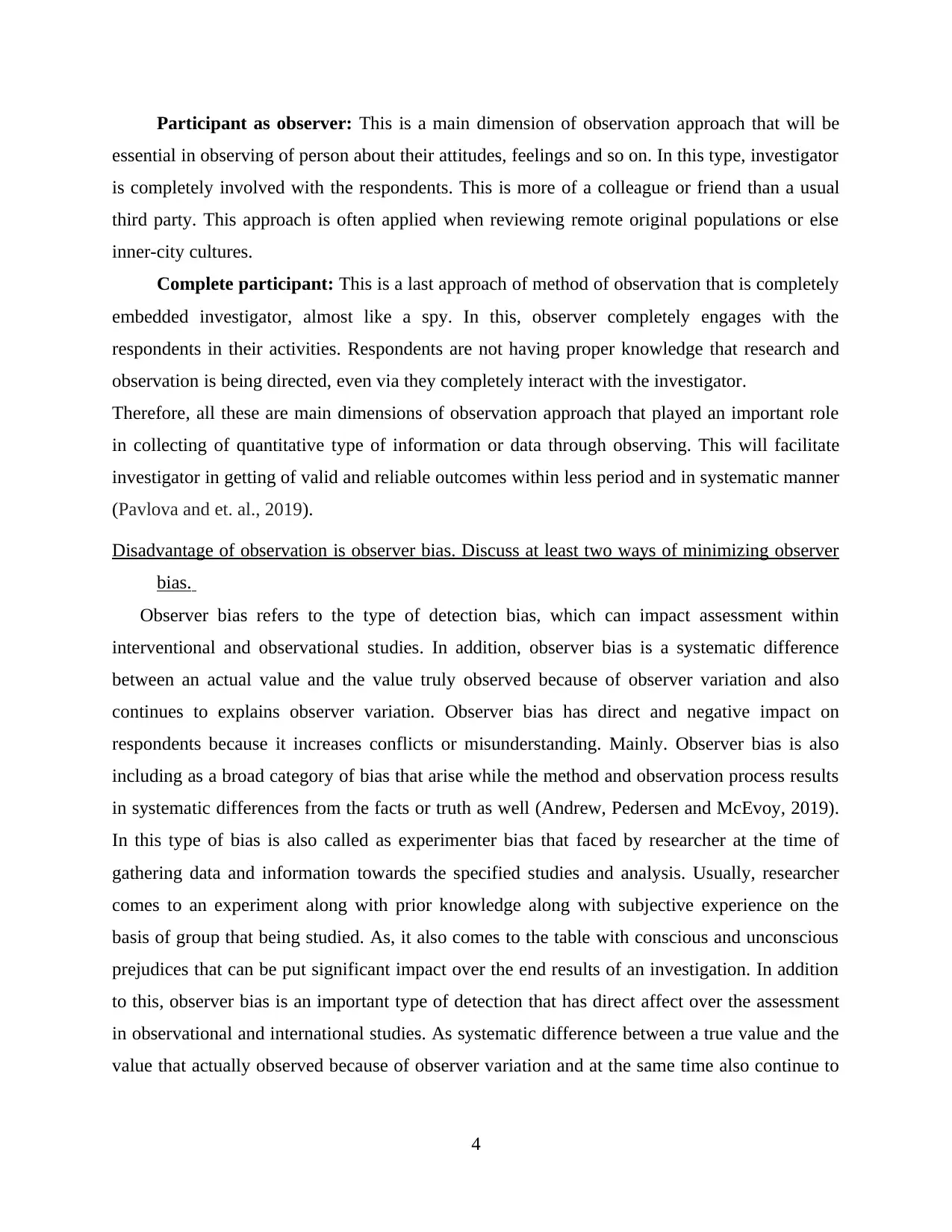
Participant as observer: This is a main dimension of observation approach that will be
essential in observing of person about their attitudes, feelings and so on. In this type, investigator
is completely involved with the respondents. This is more of a colleague or friend than a usual
third party. This approach is often applied when reviewing remote original populations or else
inner-city cultures.
Complete participant: This is a last approach of method of observation that is completely
embedded investigator, almost like a spy. In this, observer completely engages with the
respondents in their activities. Respondents are not having proper knowledge that research and
observation is being directed, even via they completely interact with the investigator.
Therefore, all these are main dimensions of observation approach that played an important role
in collecting of quantitative type of information or data through observing. This will facilitate
investigator in getting of valid and reliable outcomes within less period and in systematic manner
(Pavlova and et. al., 2019).
Disadvantage of observation is observer bias. Discuss at least two ways of minimizing observer
bias.
Observer bias refers to the type of detection bias, which can impact assessment within
interventional and observational studies. In addition, observer bias is a systematic difference
between an actual value and the value truly observed because of observer variation and also
continues to explains observer variation. Observer bias has direct and negative impact on
respondents because it increases conflicts or misunderstanding. Mainly. Observer bias is also
including as a broad category of bias that arise while the method and observation process results
in systematic differences from the facts or truth as well (Andrew, Pedersen and McEvoy, 2019).
In this type of bias is also called as experimenter bias that faced by researcher at the time of
gathering data and information towards the specified studies and analysis. Usually, researcher
comes to an experiment along with prior knowledge along with subjective experience on the
basis of group that being studied. As, it also comes to the table with conscious and unconscious
prejudices that can be put significant impact over the end results of an investigation. In addition
to this, observer bias is an important type of detection that has direct affect over the assessment
in observational and international studies. As systematic difference between a true value and the
value that actually observed because of observer variation and at the same time also continue to
4
essential in observing of person about their attitudes, feelings and so on. In this type, investigator
is completely involved with the respondents. This is more of a colleague or friend than a usual
third party. This approach is often applied when reviewing remote original populations or else
inner-city cultures.
Complete participant: This is a last approach of method of observation that is completely
embedded investigator, almost like a spy. In this, observer completely engages with the
respondents in their activities. Respondents are not having proper knowledge that research and
observation is being directed, even via they completely interact with the investigator.
Therefore, all these are main dimensions of observation approach that played an important role
in collecting of quantitative type of information or data through observing. This will facilitate
investigator in getting of valid and reliable outcomes within less period and in systematic manner
(Pavlova and et. al., 2019).
Disadvantage of observation is observer bias. Discuss at least two ways of minimizing observer
bias.
Observer bias refers to the type of detection bias, which can impact assessment within
interventional and observational studies. In addition, observer bias is a systematic difference
between an actual value and the value truly observed because of observer variation and also
continues to explains observer variation. Observer bias has direct and negative impact on
respondents because it increases conflicts or misunderstanding. Mainly. Observer bias is also
including as a broad category of bias that arise while the method and observation process results
in systematic differences from the facts or truth as well (Andrew, Pedersen and McEvoy, 2019).
In this type of bias is also called as experimenter bias that faced by researcher at the time of
gathering data and information towards the specified studies and analysis. Usually, researcher
comes to an experiment along with prior knowledge along with subjective experience on the
basis of group that being studied. As, it also comes to the table with conscious and unconscious
prejudices that can be put significant impact over the end results of an investigation. In addition
to this, observer bias is an important type of detection that has direct affect over the assessment
in observational and international studies. As systematic difference between a true value and the
value that actually observed because of observer variation and at the same time also continue to
4
Paraphrase This Document
Need a fresh take? Get an instant paraphrase of this document with our AI Paraphraser
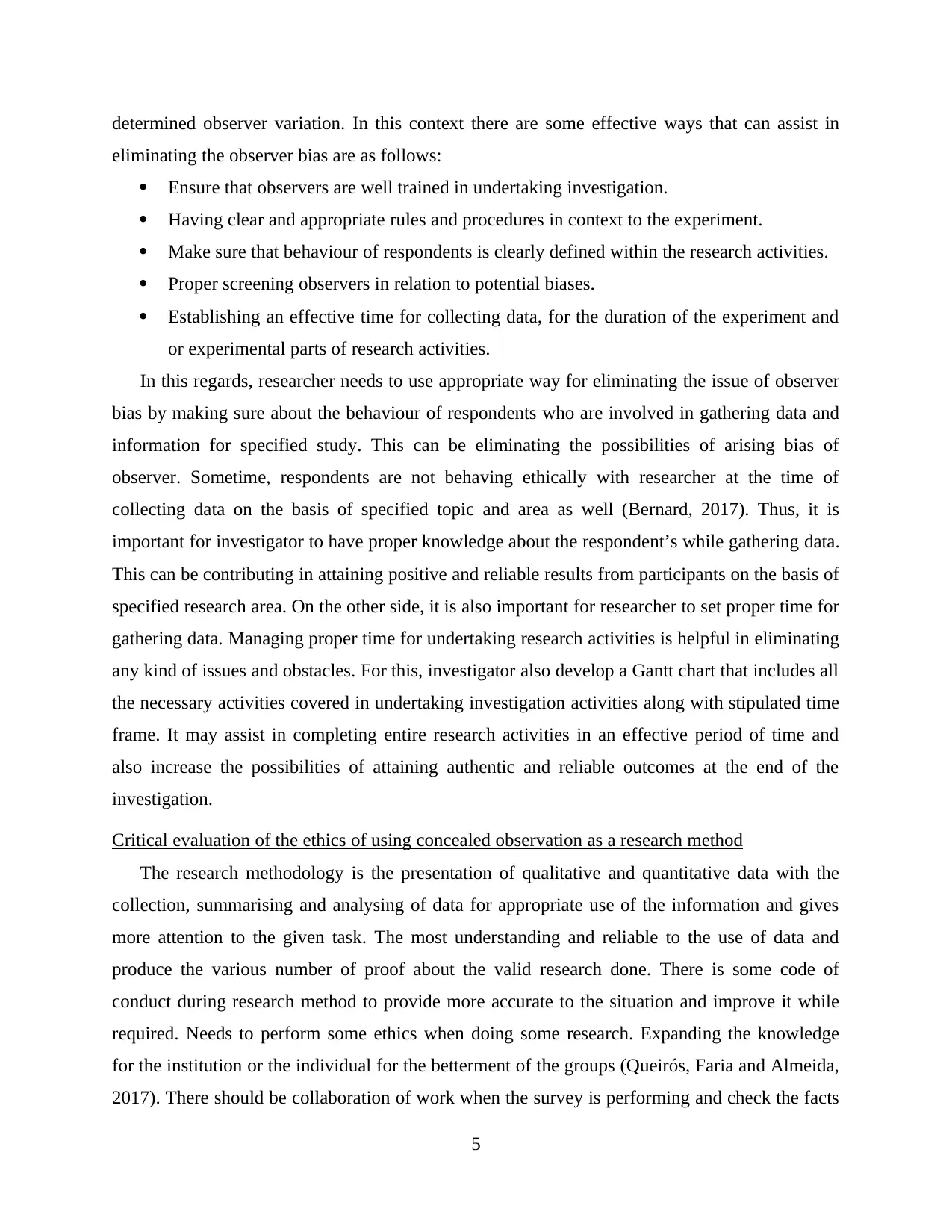
determined observer variation. In this context there are some effective ways that can assist in
eliminating the observer bias are as follows:
Ensure that observers are well trained in undertaking investigation.
Having clear and appropriate rules and procedures in context to the experiment.
Make sure that behaviour of respondents is clearly defined within the research activities.
Proper screening observers in relation to potential biases.
Establishing an effective time for collecting data, for the duration of the experiment and
or experimental parts of research activities.
In this regards, researcher needs to use appropriate way for eliminating the issue of observer
bias by making sure about the behaviour of respondents who are involved in gathering data and
information for specified study. This can be eliminating the possibilities of arising bias of
observer. Sometime, respondents are not behaving ethically with researcher at the time of
collecting data on the basis of specified topic and area as well (Bernard, 2017). Thus, it is
important for investigator to have proper knowledge about the respondent’s while gathering data.
This can be contributing in attaining positive and reliable results from participants on the basis of
specified research area. On the other side, it is also important for researcher to set proper time for
gathering data. Managing proper time for undertaking research activities is helpful in eliminating
any kind of issues and obstacles. For this, investigator also develop a Gantt chart that includes all
the necessary activities covered in undertaking investigation activities along with stipulated time
frame. It may assist in completing entire research activities in an effective period of time and
also increase the possibilities of attaining authentic and reliable outcomes at the end of the
investigation.
Critical evaluation of the ethics of using concealed observation as a research method
The research methodology is the presentation of qualitative and quantitative data with the
collection, summarising and analysing of data for appropriate use of the information and gives
more attention to the given task. The most understanding and reliable to the use of data and
produce the various number of proof about the valid research done. There is some code of
conduct during research method to provide more accurate to the situation and improve it while
required. Needs to perform some ethics when doing some research. Expanding the knowledge
for the institution or the individual for the betterment of the groups (Queirós, Faria and Almeida,
2017). There should be collaboration of work when the survey is performing and check the facts
5
eliminating the observer bias are as follows:
Ensure that observers are well trained in undertaking investigation.
Having clear and appropriate rules and procedures in context to the experiment.
Make sure that behaviour of respondents is clearly defined within the research activities.
Proper screening observers in relation to potential biases.
Establishing an effective time for collecting data, for the duration of the experiment and
or experimental parts of research activities.
In this regards, researcher needs to use appropriate way for eliminating the issue of observer
bias by making sure about the behaviour of respondents who are involved in gathering data and
information for specified study. This can be eliminating the possibilities of arising bias of
observer. Sometime, respondents are not behaving ethically with researcher at the time of
collecting data on the basis of specified topic and area as well (Bernard, 2017). Thus, it is
important for investigator to have proper knowledge about the respondent’s while gathering data.
This can be contributing in attaining positive and reliable results from participants on the basis of
specified research area. On the other side, it is also important for researcher to set proper time for
gathering data. Managing proper time for undertaking research activities is helpful in eliminating
any kind of issues and obstacles. For this, investigator also develop a Gantt chart that includes all
the necessary activities covered in undertaking investigation activities along with stipulated time
frame. It may assist in completing entire research activities in an effective period of time and
also increase the possibilities of attaining authentic and reliable outcomes at the end of the
investigation.
Critical evaluation of the ethics of using concealed observation as a research method
The research methodology is the presentation of qualitative and quantitative data with the
collection, summarising and analysing of data for appropriate use of the information and gives
more attention to the given task. The most understanding and reliable to the use of data and
produce the various number of proof about the valid research done. There is some code of
conduct during research method to provide more accurate to the situation and improve it while
required. Needs to perform some ethics when doing some research. Expanding the knowledge
for the institution or the individual for the betterment of the groups (Queirós, Faria and Almeida,
2017). There should be collaboration of work when the survey is performing and check the facts
5
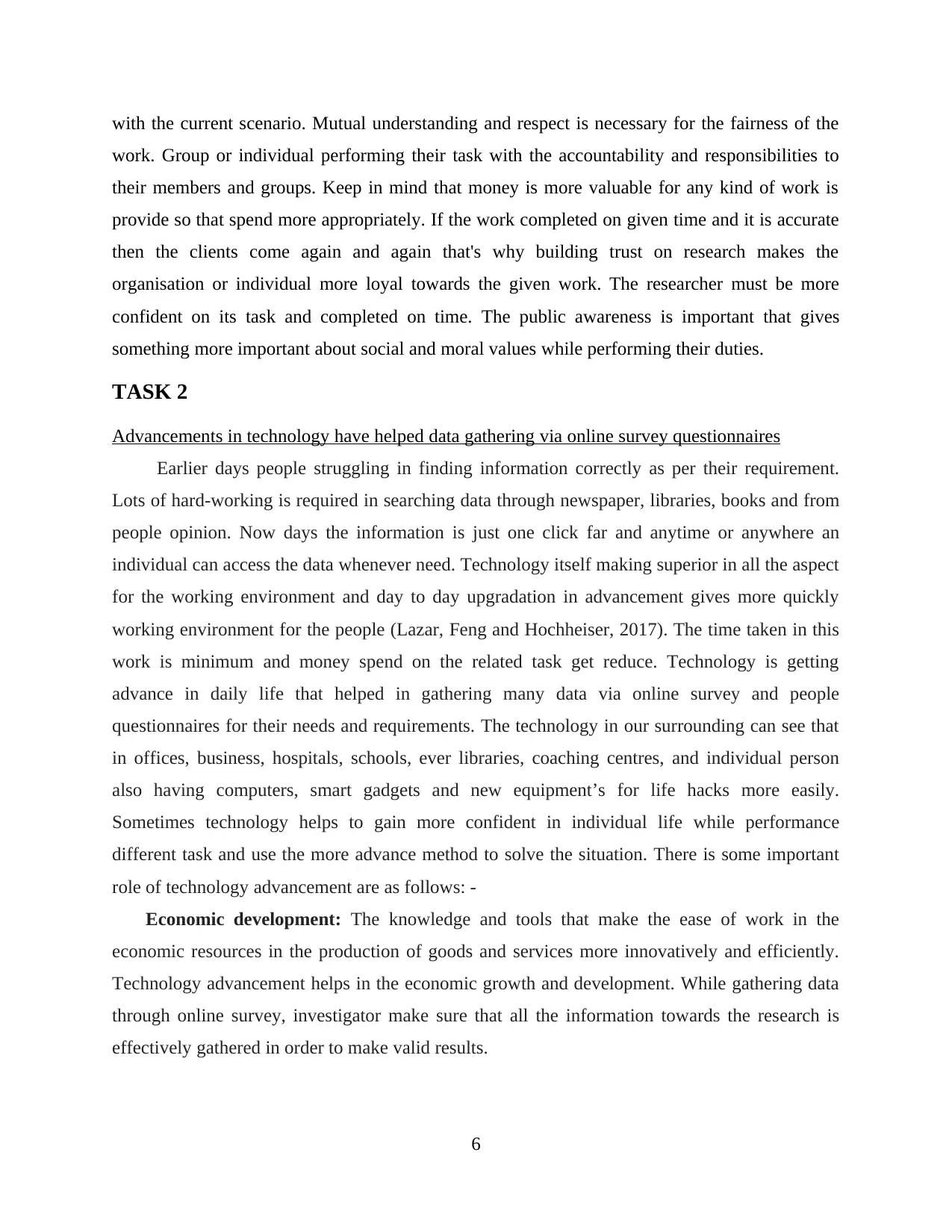
with the current scenario. Mutual understanding and respect is necessary for the fairness of the
work. Group or individual performing their task with the accountability and responsibilities to
their members and groups. Keep in mind that money is more valuable for any kind of work is
provide so that spend more appropriately. If the work completed on given time and it is accurate
then the clients come again and again that's why building trust on research makes the
organisation or individual more loyal towards the given work. The researcher must be more
confident on its task and completed on time. The public awareness is important that gives
something more important about social and moral values while performing their duties.
TASK 2
Advancements in technology have helped data gathering via online survey questionnaires
Earlier days people struggling in finding information correctly as per their requirement.
Lots of hard-working is required in searching data through newspaper, libraries, books and from
people opinion. Now days the information is just one click far and anytime or anywhere an
individual can access the data whenever need. Technology itself making superior in all the aspect
for the working environment and day to day upgradation in advancement gives more quickly
working environment for the people (Lazar, Feng and Hochheiser, 2017). The time taken in this
work is minimum and money spend on the related task get reduce. Technology is getting
advance in daily life that helped in gathering many data via online survey and people
questionnaires for their needs and requirements. The technology in our surrounding can see that
in offices, business, hospitals, schools, ever libraries, coaching centres, and individual person
also having computers, smart gadgets and new equipment’s for life hacks more easily.
Sometimes technology helps to gain more confident in individual life while performance
different task and use the more advance method to solve the situation. There is some important
role of technology advancement are as follows: -
Economic development: The knowledge and tools that make the ease of work in the
economic resources in the production of goods and services more innovatively and efficiently.
Technology advancement helps in the economic growth and development. While gathering data
through online survey, investigator make sure that all the information towards the research is
effectively gathered in order to make valid results.
6
work. Group or individual performing their task with the accountability and responsibilities to
their members and groups. Keep in mind that money is more valuable for any kind of work is
provide so that spend more appropriately. If the work completed on given time and it is accurate
then the clients come again and again that's why building trust on research makes the
organisation or individual more loyal towards the given work. The researcher must be more
confident on its task and completed on time. The public awareness is important that gives
something more important about social and moral values while performing their duties.
TASK 2
Advancements in technology have helped data gathering via online survey questionnaires
Earlier days people struggling in finding information correctly as per their requirement.
Lots of hard-working is required in searching data through newspaper, libraries, books and from
people opinion. Now days the information is just one click far and anytime or anywhere an
individual can access the data whenever need. Technology itself making superior in all the aspect
for the working environment and day to day upgradation in advancement gives more quickly
working environment for the people (Lazar, Feng and Hochheiser, 2017). The time taken in this
work is minimum and money spend on the related task get reduce. Technology is getting
advance in daily life that helped in gathering many data via online survey and people
questionnaires for their needs and requirements. The technology in our surrounding can see that
in offices, business, hospitals, schools, ever libraries, coaching centres, and individual person
also having computers, smart gadgets and new equipment’s for life hacks more easily.
Sometimes technology helps to gain more confident in individual life while performance
different task and use the more advance method to solve the situation. There is some important
role of technology advancement are as follows: -
Economic development: The knowledge and tools that make the ease of work in the
economic resources in the production of goods and services more innovatively and efficiently.
Technology advancement helps in the economic growth and development. While gathering data
through online survey, investigator make sure that all the information towards the research is
effectively gathered in order to make valid results.
6
⊘ This is a preview!⊘
Do you want full access?
Subscribe today to unlock all pages.

Trusted by 1+ million students worldwide
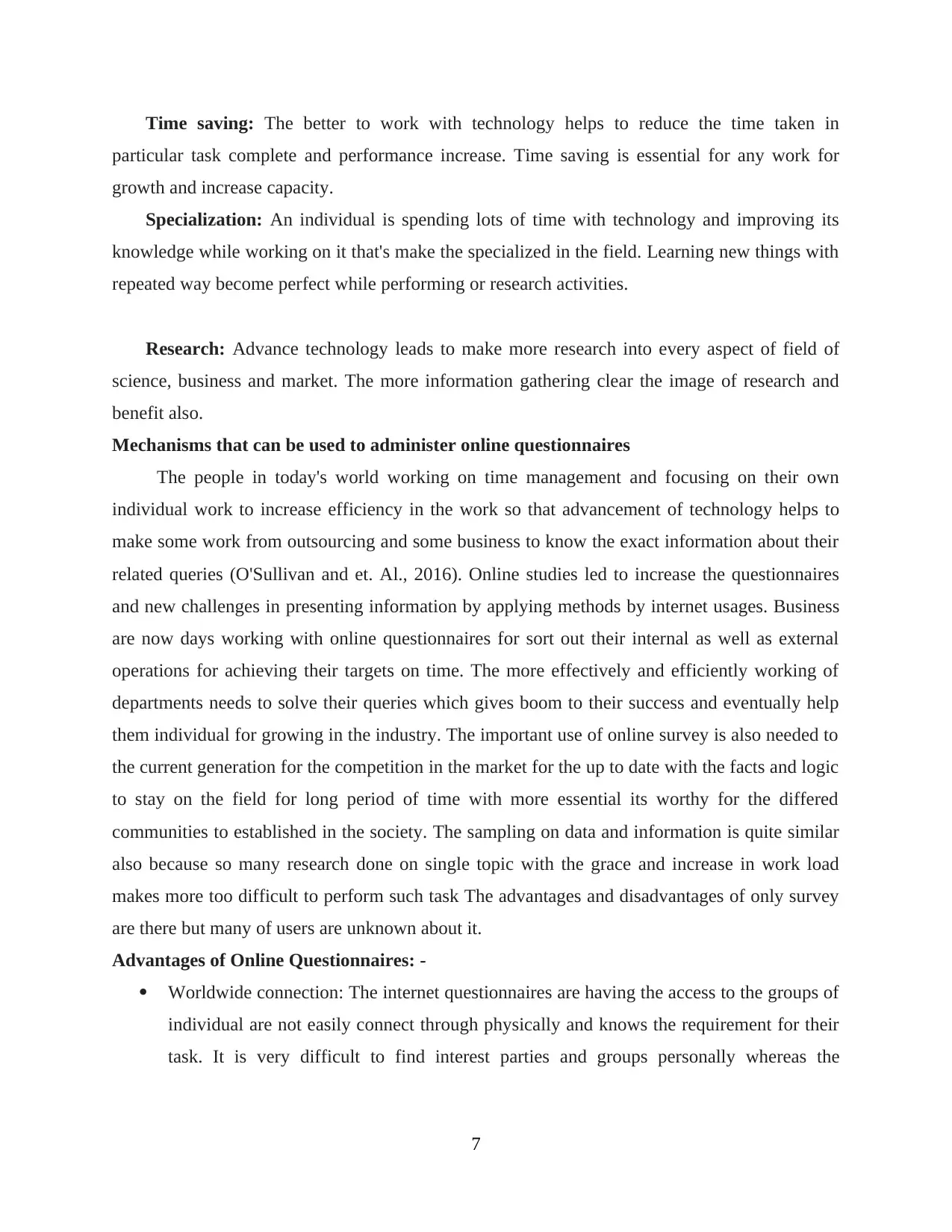
Time saving: The better to work with technology helps to reduce the time taken in
particular task complete and performance increase. Time saving is essential for any work for
growth and increase capacity.
Specialization: An individual is spending lots of time with technology and improving its
knowledge while working on it that's make the specialized in the field. Learning new things with
repeated way become perfect while performing or research activities.
Research: Advance technology leads to make more research into every aspect of field of
science, business and market. The more information gathering clear the image of research and
benefit also.
Mechanisms that can be used to administer online questionnaires
The people in today's world working on time management and focusing on their own
individual work to increase efficiency in the work so that advancement of technology helps to
make some work from outsourcing and some business to know the exact information about their
related queries (O'Sullivan and et. Al., 2016). Online studies led to increase the questionnaires
and new challenges in presenting information by applying methods by internet usages. Business
are now days working with online questionnaires for sort out their internal as well as external
operations for achieving their targets on time. The more effectively and efficiently working of
departments needs to solve their queries which gives boom to their success and eventually help
them individual for growing in the industry. The important use of online survey is also needed to
the current generation for the competition in the market for the up to date with the facts and logic
to stay on the field for long period of time with more essential its worthy for the differed
communities to established in the society. The sampling on data and information is quite similar
also because so many research done on single topic with the grace and increase in work load
makes more too difficult to perform such task The advantages and disadvantages of only survey
are there but many of users are unknown about it.
Advantages of Online Questionnaires: -
Worldwide connection: The internet questionnaires are having the access to the groups of
individual are not easily connect through physically and knows the requirement for their
task. It is very difficult to find interest parties and groups personally whereas the
7
particular task complete and performance increase. Time saving is essential for any work for
growth and increase capacity.
Specialization: An individual is spending lots of time with technology and improving its
knowledge while working on it that's make the specialized in the field. Learning new things with
repeated way become perfect while performing or research activities.
Research: Advance technology leads to make more research into every aspect of field of
science, business and market. The more information gathering clear the image of research and
benefit also.
Mechanisms that can be used to administer online questionnaires
The people in today's world working on time management and focusing on their own
individual work to increase efficiency in the work so that advancement of technology helps to
make some work from outsourcing and some business to know the exact information about their
related queries (O'Sullivan and et. Al., 2016). Online studies led to increase the questionnaires
and new challenges in presenting information by applying methods by internet usages. Business
are now days working with online questionnaires for sort out their internal as well as external
operations for achieving their targets on time. The more effectively and efficiently working of
departments needs to solve their queries which gives boom to their success and eventually help
them individual for growing in the industry. The important use of online survey is also needed to
the current generation for the competition in the market for the up to date with the facts and logic
to stay on the field for long period of time with more essential its worthy for the differed
communities to established in the society. The sampling on data and information is quite similar
also because so many research done on single topic with the grace and increase in work load
makes more too difficult to perform such task The advantages and disadvantages of only survey
are there but many of users are unknown about it.
Advantages of Online Questionnaires: -
Worldwide connection: The internet questionnaires are having the access to the groups of
individual are not easily connect through physically and knows the requirement for their
task. It is very difficult to find interest parties and groups personally whereas the
7
Paraphrase This Document
Need a fresh take? Get an instant paraphrase of this document with our AI Paraphraser
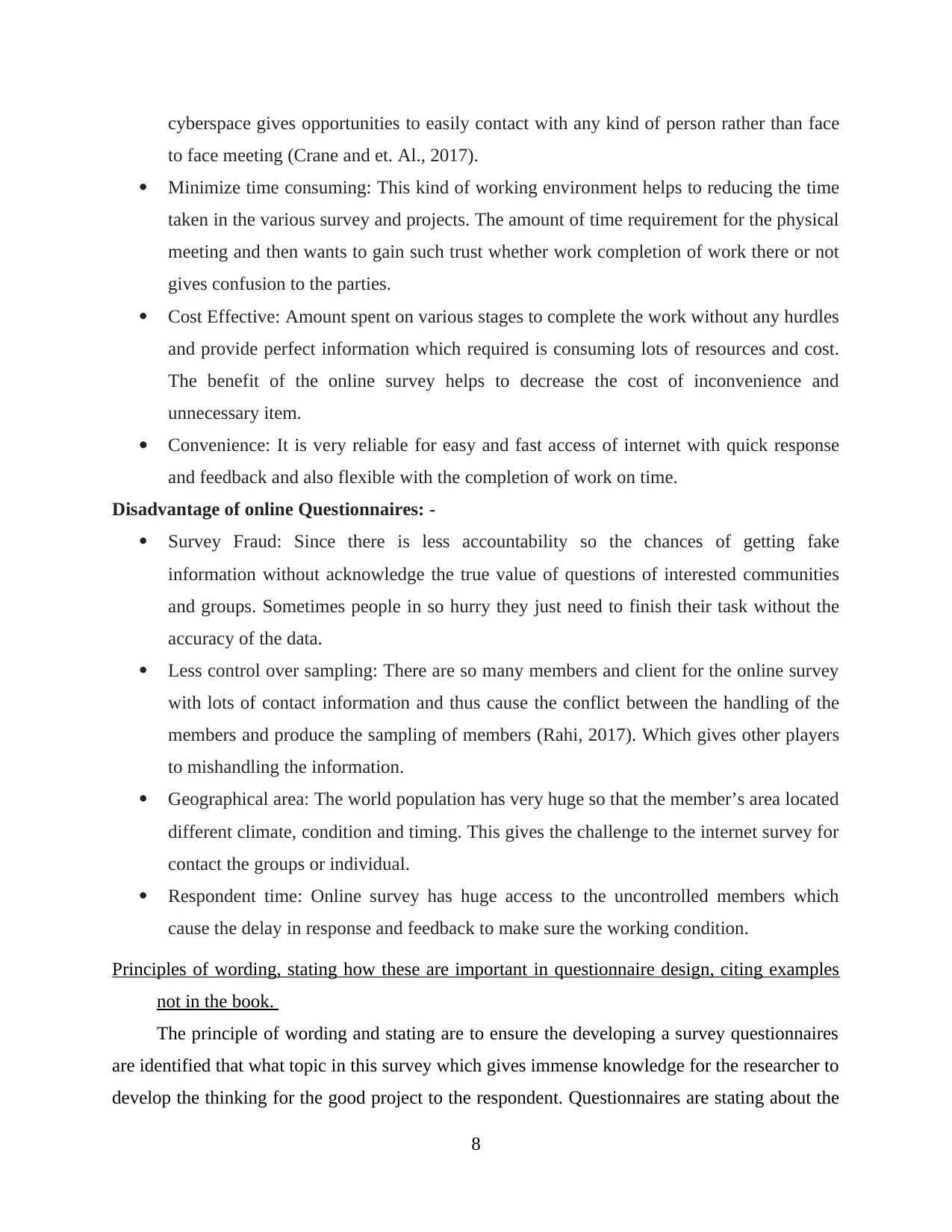
cyberspace gives opportunities to easily contact with any kind of person rather than face
to face meeting (Crane and et. Al., 2017).
Minimize time consuming: This kind of working environment helps to reducing the time
taken in the various survey and projects. The amount of time requirement for the physical
meeting and then wants to gain such trust whether work completion of work there or not
gives confusion to the parties.
Cost Effective: Amount spent on various stages to complete the work without any hurdles
and provide perfect information which required is consuming lots of resources and cost.
The benefit of the online survey helps to decrease the cost of inconvenience and
unnecessary item.
Convenience: It is very reliable for easy and fast access of internet with quick response
and feedback and also flexible with the completion of work on time.
Disadvantage of online Questionnaires: -
Survey Fraud: Since there is less accountability so the chances of getting fake
information without acknowledge the true value of questions of interested communities
and groups. Sometimes people in so hurry they just need to finish their task without the
accuracy of the data.
Less control over sampling: There are so many members and client for the online survey
with lots of contact information and thus cause the conflict between the handling of the
members and produce the sampling of members (Rahi, 2017). Which gives other players
to mishandling the information.
Geographical area: The world population has very huge so that the member’s area located
different climate, condition and timing. This gives the challenge to the internet survey for
contact the groups or individual.
Respondent time: Online survey has huge access to the uncontrolled members which
cause the delay in response and feedback to make sure the working condition.
Principles of wording, stating how these are important in questionnaire design, citing examples
not in the book.
The principle of wording and stating are to ensure the developing a survey questionnaires
are identified that what topic in this survey which gives immense knowledge for the researcher to
develop the thinking for the good project to the respondent. Questionnaires are stating about the
8
to face meeting (Crane and et. Al., 2017).
Minimize time consuming: This kind of working environment helps to reducing the time
taken in the various survey and projects. The amount of time requirement for the physical
meeting and then wants to gain such trust whether work completion of work there or not
gives confusion to the parties.
Cost Effective: Amount spent on various stages to complete the work without any hurdles
and provide perfect information which required is consuming lots of resources and cost.
The benefit of the online survey helps to decrease the cost of inconvenience and
unnecessary item.
Convenience: It is very reliable for easy and fast access of internet with quick response
and feedback and also flexible with the completion of work on time.
Disadvantage of online Questionnaires: -
Survey Fraud: Since there is less accountability so the chances of getting fake
information without acknowledge the true value of questions of interested communities
and groups. Sometimes people in so hurry they just need to finish their task without the
accuracy of the data.
Less control over sampling: There are so many members and client for the online survey
with lots of contact information and thus cause the conflict between the handling of the
members and produce the sampling of members (Rahi, 2017). Which gives other players
to mishandling the information.
Geographical area: The world population has very huge so that the member’s area located
different climate, condition and timing. This gives the challenge to the internet survey for
contact the groups or individual.
Respondent time: Online survey has huge access to the uncontrolled members which
cause the delay in response and feedback to make sure the working condition.
Principles of wording, stating how these are important in questionnaire design, citing examples
not in the book.
The principle of wording and stating are to ensure the developing a survey questionnaires
are identified that what topic in this survey which gives immense knowledge for the researcher to
develop the thinking for the good project to the respondent. Questionnaires are stating about the
8
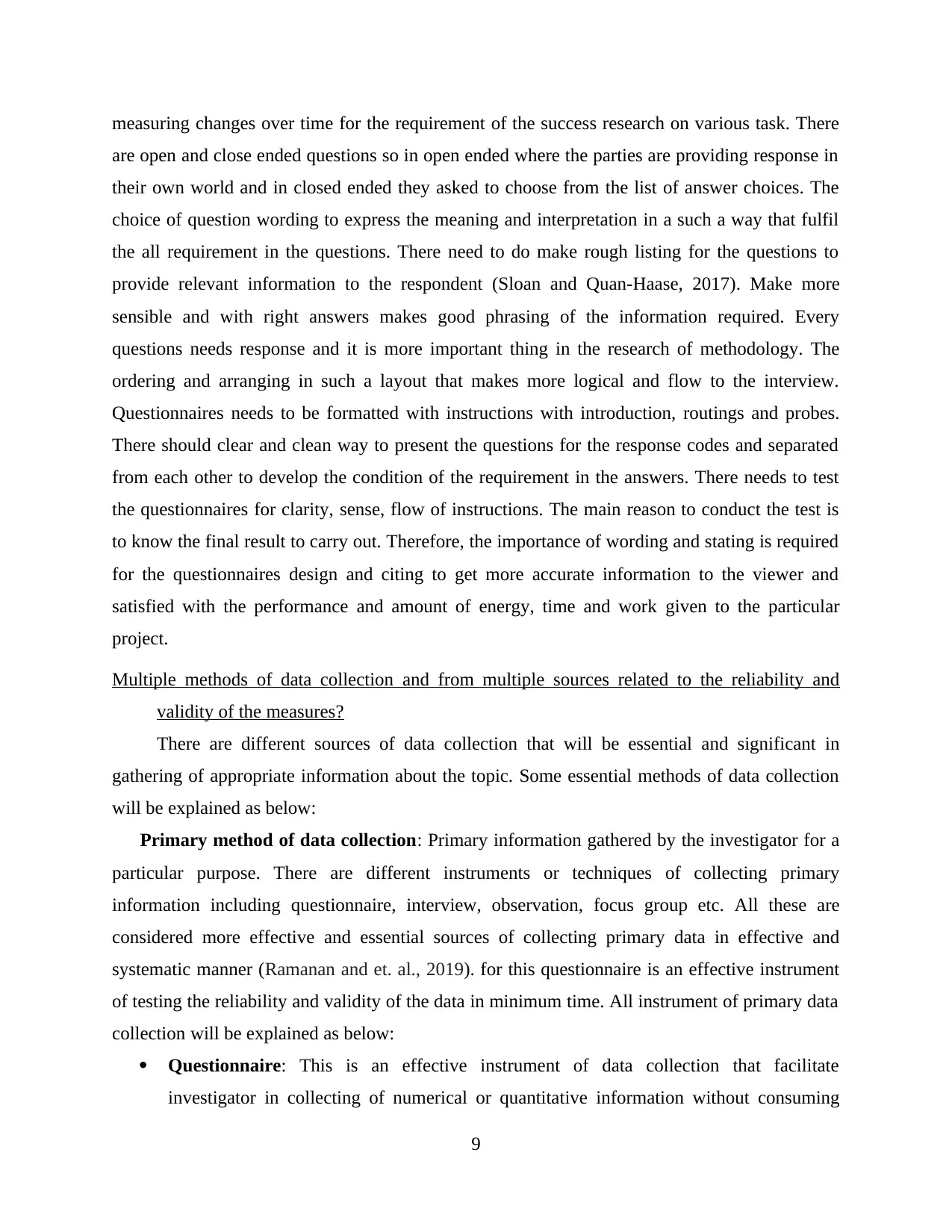
measuring changes over time for the requirement of the success research on various task. There
are open and close ended questions so in open ended where the parties are providing response in
their own world and in closed ended they asked to choose from the list of answer choices. The
choice of question wording to express the meaning and interpretation in a such a way that fulfil
the all requirement in the questions. There need to do make rough listing for the questions to
provide relevant information to the respondent (Sloan and Quan-Haase, 2017). Make more
sensible and with right answers makes good phrasing of the information required. Every
questions needs response and it is more important thing in the research of methodology. The
ordering and arranging in such a layout that makes more logical and flow to the interview.
Questionnaires needs to be formatted with instructions with introduction, routings and probes.
There should clear and clean way to present the questions for the response codes and separated
from each other to develop the condition of the requirement in the answers. There needs to test
the questionnaires for clarity, sense, flow of instructions. The main reason to conduct the test is
to know the final result to carry out. Therefore, the importance of wording and stating is required
for the questionnaires design and citing to get more accurate information to the viewer and
satisfied with the performance and amount of energy, time and work given to the particular
project.
Multiple methods of data collection and from multiple sources related to the reliability and
validity of the measures?
There are different sources of data collection that will be essential and significant in
gathering of appropriate information about the topic. Some essential methods of data collection
will be explained as below:
Primary method of data collection: Primary information gathered by the investigator for a
particular purpose. There are different instruments or techniques of collecting primary
information including questionnaire, interview, observation, focus group etc. All these are
considered more effective and essential sources of collecting primary data in effective and
systematic manner (Ramanan and et. al., 2019). for this questionnaire is an effective instrument
of testing the reliability and validity of the data in minimum time. All instrument of primary data
collection will be explained as below:
Questionnaire: This is an effective instrument of data collection that facilitate
investigator in collecting of numerical or quantitative information without consuming
9
are open and close ended questions so in open ended where the parties are providing response in
their own world and in closed ended they asked to choose from the list of answer choices. The
choice of question wording to express the meaning and interpretation in a such a way that fulfil
the all requirement in the questions. There need to do make rough listing for the questions to
provide relevant information to the respondent (Sloan and Quan-Haase, 2017). Make more
sensible and with right answers makes good phrasing of the information required. Every
questions needs response and it is more important thing in the research of methodology. The
ordering and arranging in such a layout that makes more logical and flow to the interview.
Questionnaires needs to be formatted with instructions with introduction, routings and probes.
There should clear and clean way to present the questions for the response codes and separated
from each other to develop the condition of the requirement in the answers. There needs to test
the questionnaires for clarity, sense, flow of instructions. The main reason to conduct the test is
to know the final result to carry out. Therefore, the importance of wording and stating is required
for the questionnaires design and citing to get more accurate information to the viewer and
satisfied with the performance and amount of energy, time and work given to the particular
project.
Multiple methods of data collection and from multiple sources related to the reliability and
validity of the measures?
There are different sources of data collection that will be essential and significant in
gathering of appropriate information about the topic. Some essential methods of data collection
will be explained as below:
Primary method of data collection: Primary information gathered by the investigator for a
particular purpose. There are different instruments or techniques of collecting primary
information including questionnaire, interview, observation, focus group etc. All these are
considered more effective and essential sources of collecting primary data in effective and
systematic manner (Ramanan and et. al., 2019). for this questionnaire is an effective instrument
of testing the reliability and validity of the data in minimum time. All instrument of primary data
collection will be explained as below:
Questionnaire: This is an effective instrument of data collection that facilitate
investigator in collecting of numerical or quantitative information without consuming
9
⊘ This is a preview!⊘
Do you want full access?
Subscribe today to unlock all pages.

Trusted by 1+ million students worldwide
1 out of 18
Related Documents
Your All-in-One AI-Powered Toolkit for Academic Success.
+13062052269
info@desklib.com
Available 24*7 on WhatsApp / Email
![[object Object]](/_next/static/media/star-bottom.7253800d.svg)
Unlock your academic potential
Copyright © 2020–2025 A2Z Services. All Rights Reserved. Developed and managed by ZUCOL.





